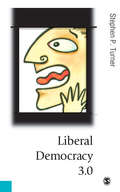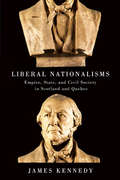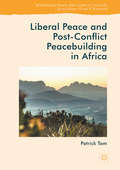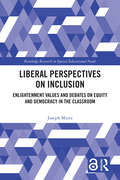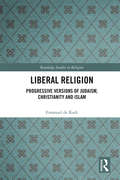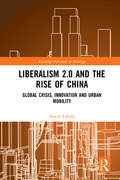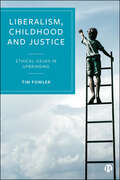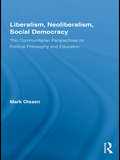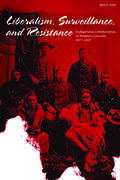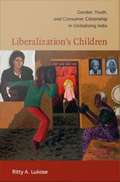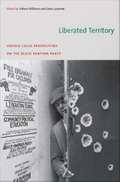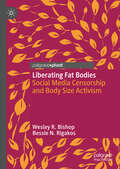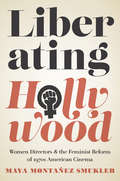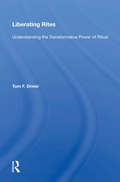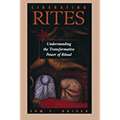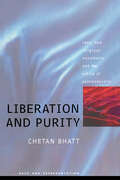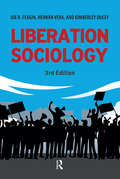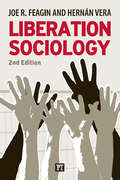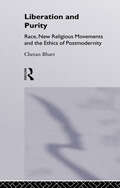- Table View
- List View
Liberal Christianity and Women's Global Activism: The YWCA of the USA and the Maryknoll Sisters
by Amanda IzzoReligiously influenced social movements tend to be characterized as products of the conservative turn in Protestant and Catholic life in the latter part of the twentieth century, with women's mobilizations centering on defense of the “traditional” family. In Liberal Christianity and Women’s Global Activism, Amanda L. Izzo argues that, contrary to this view, liberal wings of Christian churches have remained an instrumental presence in U.S. and transnational politics. Women have been at the forefront of such efforts. Focusing on the histories of two highly influential groups, the Young Women’s Christian Association of the USA, an interdenominational Protestant organization, and the Maryknoll Sisters, a Roman Catholic religious order, Izzo offers new perspectives on the contributions of these women to transnational social movements, women’s history, and religious studies, as she traces the connections between turn-of-the-century Christian women’s reform culture and liberal and left-wing religious social movements of the 1960s and 1970s. Izzo suggests that shared ethical, theological, and institutional underpinnings can transcend denominational divides, and that strategies for social change often associated with secular feminism have ties to spiritually inspired social movements.
Liberal Democracy 3.0: Civil Society in an Age of Experts (Published in association with Theory, Culture & Society)
by Stephen Turner`This is a very fine text, a powerful piece of work that deserves to be read widely. The analysis is truly panoramic. It ranges across central concerns in the fields of social theory, political theory, and science studies and engages with and/or draws upon the ideas of key classical and contemporary thinkers, including Tocqueville, Weber, Schumpeter, Polyani, Habermas, Foucault, Schmitt and Beck' - Barry Smart, Professor of Sociology, University of Portsmouth What are the political implications of 'expert' knowledge and especially scientific knowledge for liberal democracy? If knowledge is not evenly distributed upon what basis can the philosophy of equal rights be sustained? This important book points to the crisis in knowledge in liberal democracies. This crisis, simply put, is that most citizens cannot understand, much less judge, the claims scientists make. One response is the appointment of public commissions to provide conclusions for policy-makers to act upon. There are also `commissions from below', such as grass roots associations that quiz the limits of expert knowledge and power and make rival knowledge claims. Do these commissions represent a new stage in the development of liberal democracy? Or is it merely a pragmatic device of no political consequence. The central argument of the book is that in a `knowledge society' in which specialized knowledge is increasingly important to politics, more has to be delegated because democratic discussion can't handle it. This limitation in the scope of liberal democracy threatens its fundamental character. The book will be required reading in the fields of social theory, political theory and science studies.
Liberal Nationalisms
by James KennedyThe early twentieth century witnessed the emergence of Scottish and Quebec nationalisms that were closely intertwined with liberal philosophies. The Young Scots' Society and the Ligue nationaliste canadienne carried these liberal nationalist ideas. This book offers a comparative and historical examination of their ideas and politics, exploring the Young Scots as a movement, as well as the ideas of key Nationalistes. James Kennedy argues that the growth of the Young Scots' Society and the Ligue nationaliste canadienne was largely in response to changes within empire, state, and civil society. He suggests that the actions of the British Empire and the Canadian state not only prompted nationalist responses in Scotland and Quebec respectively, but also shaped their liberal character. His comparative analysis provides insights that would not arise from a single case study of either movement, while detailing the important roles that geopolitics, consociation and federation, and organized religion played in the creation of nationalist philosophies. The first-ever comparative history of nationalism in Scotland and Quebec, Liberal Nationalisms is an insightful study of nascent political nationalisms and a major contribution to the scholarship of nationalist movements in the early twentieth century.
Liberal Nationalisms: Empire, State, and Civil Society in Scotland and Quebec
by James KennedyThe early twentieth century witnessed the emergence of Scottish and Quebec nationalisms that were closely intertwined with liberal philosophies. The Young Scots' Society and the Ligue nationaliste canadienne carried these liberal nationalist ideas. This book offers a comparative and historical examination of their ideas and politics, exploring the Young Scots as a movement, as well as the ideas of key Nationalistes. James Kennedy argues that the growth of the Young Scots' Society and the Ligue nationaliste canadienne was largely in response to changes within empire, state, and civil society. He suggests that the actions of the British Empire and the Canadian state not only prompted nationalist responses in Scotland and Quebec respectively, but also shaped their liberal character. His comparative analysis provides insights that would not arise from a single case study of either movement, while detailing the important roles that geopolitics, consociation and federation, and organized religion played in the creation of nationalist philosophies. The first-ever comparative history of nationalism in Scotland and Quebec, Liberal Nationalisms is an insightful study of nascent political nationalisms and a major contribution to the scholarship of nationalist movements in the early twentieth century.
Liberal Peace and Post-Conflict Peacebuilding in Africa
by Patrick TomThe book makes theoretical and empirical contributions to recent debates on hybrid forms of peace and 'post-liberal' peace. In applying concepts of power, hybridity and resistance, and providing different kinds of hybridity and resistance to explore post-conflict peacebuilding in Sierra Leone, the author makes an original contribution to existing literature by providing various ways in which power can be exercised not just between locals and internationals, but also among locals themselves and the nature of peace that is produced. This volume provides various ways in which hybridity and resistance can be manifested. A more rigorous development of these concepts not only offers a better understanding of the nature of these concepts, but also helps us to distinguish forms of hybridity and resistance that are emancipatory or transformatory from those that result in people accommodating themselves to their situation. This book is an invaluable resource for scholars and students of peacebuilding, peace and conflict studies, International Relations and African Studies, and practitioners of peacebuilding and post-conflict reconstruction.
Liberal Perspectives on Inclusion: Enlightenment Values and Debates on Equity and Democracy in the Classroom (Routledge Research in Special Educational Needs)
by Joseph MintzProviding a theoretical underpinning for the idea of inclusion within education, this book recognizes the fundamental role political values play in our understanding of inclusion in the classroom, providing a philosophical lens on the inherent tensions that exist within sociological perspectives on social justice, equity and diversity.Chapters address value tensions from the perspective of classical liberalism and the extent to which this can be reconciled with values pluralism and Berlin’s notions of negative and positive liberty. The book argues for a re-framing of inclusion as a process of negotiation between teachers, parents, children and young people which involves a recognition of the complex tradeoffs involved in working with difference in the classroom. These tensions are explored through a series of case studies of real-world dilemmas in the classroom, ultimately serving to highlight the ways in which varying political value positions, including liberalism, are inescapably embedded within the practice in education.Considering topics such as decolonization of the curriculum, freedom of speech and social justice, this seminal volume will be highly relevant for researchers, scholars and postgraduate students in the fields of inclusive education, special educational needs, philosophy of education, social justice and education and critical theory.
Liberal Religion: Progressive versions of Judaism, Christianity and Islam (Routledge Studies in Religion)
by Emanuel de KadtIn recent years, there has been an upsurge of interest in religion and religious issues. Some have linked this to a neo-liberal form of individualism, while others noted that secularism has left people bereft of a humanly necessary link with the transcendent. The importance of identity issues has also been remarked upon. This book examines how liberal forms of religion are allowing people to engage with religion on their own terms, while also feeling part of something more universal. Looking at liberal approaches to the Abrahamic faiths – Judaism, Protestant and Roman Catholic Christianity and Islam – this book teases out how postmodern culture has shaped the way in which people engage with these religions. It also compares and contrasts how liberal thinking and theology have been expressed in each of the faiths examined, as well as the reactionary responses to its emergence. By considering how liberalism has influenced the narrative around the Abrahamic faiths, this book demonstrates how malleable faith and spirituality can be. As such, it will be of interest to scholars working in Religious Studies, Theology, Sociology and Cultural Anthropology.
Liberalised India, Politicised Middle Class and Software Professionals
by Anshu SrivastavaThis volume explores the emergence, evolution and definition of the middle class in India. As a class created as the interpreters between the colonial rulers and the millions whom they governed in the pre-Independence era, the Indian middle class has existed in congruence with the state, occupying vital positions in state administration. Since Independence, this middle class underwent major sociological change as they live independent of the state, which affected their social, economic and political position, reaping benefits of liberalisation and globalisation through education and employment. An otherwise internally differentiated and heterogeneous group, the new Indian middle class often unifies itself to shape socio-political discourse that affects politics and policymaking, from domestic to international affairs. This volume analyses this class phenomenon through a close study of a new metropolitan middle class in India – the software professionals, emblematic of the 'new India’. It discusses this emerging class as a political category and their engagements with the state, democracy, political parties, issues of gender, basic necessities and social justice. Further, it discusses their social action and ‘middle class activism’ for issues such as environment, cleanliness and corruption, particularly highlighting its presence in the private sector and electronic media. A fresh perspective on India’s political milieu, this volume will be of interest to scholars and researchers of sociology, modern Indian history, political science, economics and South Asia studies.
Liberalising Foreign Direct Investment Policies in the APEC Region (Routledge Revivals Ser.)
by Bernie BishopThis title was first published in 2001. This work is a response to criticisms that investment liberalization in the APEC region is not moving quickly enough. It commences with a historical overview of APEC's process for investment liberalization and a description of current foreign direct investment policies for each of the APEC economies. It then argues that there are significant constraints to further liberalization arising from economic development concerns in the developing countries and political considerations in both developed and developing countries in the region. It also suggests that a truly liberalized investment environment would involve the removal of investment incentives. Again, there are political and institutional reasons that make this difficult. With several suggestions for further research that should better inform policy makers, this is an informative insight into the complex issues involved in the liberalization process in the APEC region.
Liberalism 2.0 and the Rise of China: Global Crisis, Innovation and Urban Mobility (Routledge Advances in Sociology)
by David TyfieldWhat can we do in this period of historic, global turbulence? Mainstream narratives have no plausible account of how to stop exacerbating the multiple, overlapping challenges; much less begin to address them meaningfully. The only thing everyone agrees is innovation will be needed. But what is innovation? Usually, it is understood as new technologies that will ‘solve’ specific ‘problems’ – and, it is hoped, return life to a ‘business as usual’ of progress in individual freedom and wealth. But innovation is a thoroughly social process with profound implications for the arrangement of power in a society, hence shaping the emergence of new social systems. Exploring evidence from the key arenas of low-carbon innovation, including in the pivotal location of a rising China, this book describes the global systemic crisis of a neoliberal world order and the embryonic emergence of an alternative global power regime of a ‘liberalism 2.0’. This augurs both a web 2.0-based revitalization of the classical liberalism of the nineteenth century and new Dickensian inequalities and injustices. Against hopes that the present is a ‘revolutionary’ moment, therefore, political engagement with this emerging power regime is thus presented as the most productive strategy for a progressive twenty-first century politics.
Liberalism, Childhood and Justice: Ethical Issues in Upbringing
by Tim FowlerCombining political philosophy with sociological perspectives, this radical and critical account of family justice explores children’s wellbeing and ethical issues in children’s upbringing. Fowler reconceptualises what constitutes children’s wellbeing, the duties of parents to promote children’s wellbeing and the collective obligations of state and society to ensure that children’s best interests are advanced and protected. Arguing that the wellbeing of children should not be measured in terms of subjective happiness but rather by them coming to hold an appropriate set of values and aspirations, Fowler challenges the dominant liberal model of parenting and calls instead for all citizens to be responsible for guaranteeing that children lead flourishing lives.
Liberalism, Human Values and Schools as Microcosms of Society: Rediscovering Education for a Moral Future (Routledge International Studies in the Philosophy of Education)
by Martin CohenThis seminal volume provides an accessible overview of key ethical and philosophical debates surrounding contemporary education policy, advocating for a future in education that is primarily driven by prioritising social values.Grounded in the educational ideas of recent British liberal and philosophical thinkers, including Roger Scruton, Mary Midgley and Brenda Almond in particular, the book provides a deeper understanding of the importance of intellectual and moral freedom as it plays out in today’s schools. The book echoes Almond’s call for education to be viewed through the lens of social values and argues for a broader societal strategy to the philosophy of education than narrowly utilitarian attempts to prepare pupils for the labour market. Chapters present various debates in society that relate to liberalism, social values and utilitarianism, and ultimately encourage dialogue on the approach towards education that is necessary to create a socially adjusted, thoughtful and genuinely knowledgeable society of the future.By encouraging readers to think about the requirements of the schools of tomorrow along with their role in shaping both individual lives and society itself, this book will be of interest to scholars, postgraduate students and researchers in the fields of philosophy of education, education studies and moral and value education. Those interested in the sociology of education and citizenship studies more broadly will also benefit from the volume.
Liberalism, Neoliberalism, Social Democracy: Thin Communitarian Perspectives on Political Philosophy and Education (Routledge Studies in Social and Political Thought)
by Mark OlssenThe Credit Crunch of 2008 has exposed the fallacies of neoliberalism and its thesis of the self-regulating market, which has been ascendant in both economic theory and policy over the last 30 years. In moving beyond neoliberalism, social democratic arguments are once again coming to the fore; however, in the context of the 21st century, they will need to be theorized in relation to new global concerns. This book critically revisits the core theses of liberalism and neoliberalism that have provided philosophical support to free market economics - as enunciated in the writings of liberal political philosophers such as Friedrich von Hayek, Karl Popper and Isaiah Berlin - and seeks to expose the deficiencies of their beliefs that became hegemonic from the 1970s until the first decades of the present century. In moving beyond the formulas and mantras of liberalism, the book seeks to re-theorize social democracy and articulate a new vision of the political arrangements needed for the 21st century by reconsidering issues such as liberty, autonomy, social dependence and multiculturalism.
Liberalism, Surveillances and Resistance
by Keith D. SmithIndigenous communities in Western Canada, 1877-1927
Liberalization's Children: Gender, Youth, and Consumer Citizenship in Globalizing India
by Ritty A. LukoseLiberalization's Children explores how youth and gender have become crucial sites for a contested cultural politics of globalization in India. Popular discourses draw a contrast between "midnight's children," who were rooted in post-independence Nehruvian developmentalism, and "liberalization's children," who are global in outlook and unapologetically consumerist. Moral panics about beauty pageants and the celebration of St. Valentine's Day reflect ambivalence about the impact of an expanding commodity culture, especially on young women. By simply highlighting the triumph of consumerism, such discourses obscure more than they reveal. Through a careful analysis of "consumer citizenship," Ritty A. Lukose argues that the breakdown of the Nehruvian vision connects with ongoing struggles over the meanings of public life and the cultural politics of belonging. Those struggles play out in the ascendancy of Hindu nationalism; reconfigurations of youthful, middle-class femininity; attempts by the middle class to alter understandings of citizenship; and assertions of new forms of masculinity by members of lower castes. Moving beyond elite figurations of globalizing Indian youth, Lukose draws on ethnographic research to examine how non-elite college students in the southern state of Kerala mediate region, nation, and globe. Kerala sits at the crossroads of development and globalization. Held up as a model of left-inspired development, it has also been transformed through an extensive and largely non-elite transnational circulation of labor, money, and commodities to the Persian Gulf and elsewhere. Focusing on fashion, romance, student politics, and education, Lukose carefully tracks how gender, caste, and class, as well as colonial and postcolonial legacies of culture and power, affect how students navigate their roles as citizens and consumers. She explores how mass-mediation and an expanding commodity culture have differentially incorporated young people into the structures and aspirational logics of globalization.
Liberated Territory: Untold Local Perspectives On the Black Panther Party
by Jama Lazerow Yohuru WilliamsWith their collection In Search of the Black Panther Party, Yohuru Williams and Jama Lazerow provided a broad analysis of the Black Panther Party and its legacy. In Liberated Territory, they turn their attention to local manifestations of the organization, far away from the party's Oakland headquarters. This collection's contributors, all historians, examine how specific party chapters and offshoots emerged, developed, and waned, as well as how the local branches related to their communities and to the national party. The histories and character of the party branches vary as widely as their locations. The Cape Verdeans of New Bedford, Massachusetts, were initially viewed as a particular challenge for the local Panthers but later became the mainstay of the Boston-area party. In the early 1970s, the Winston-Salem, North Carolina, chapter excelled at implementing the national Black Panther Party's strategic shift from revolutionary confrontation to mainstream electoral politics. In Detroit, the Panthers were defined by a complex relationship between their above-ground activities and an underground wing dedicated to armed struggle. While the Milwaukee chapter was born out of a rising tide of black militancy, it ultimately proved more committed to promoting literacy and health care and redressing hunger than to violence. The Alabama Black Liberation Front did not have the official imprimatur of the national party, but it drew heavily on the Panthers' ideas and organizing strategies, and its activism demonstrates the broad resonance of many of the concerns articulated by the national party: the need for jobs, for decent food and housing, for black self-determination, and for sustained opposition to police brutality against black people. Liberated Territory reveals how the Black Panther Party's ideologies, goals, and strategies were taken up and adapted throughout the United States. Contributors: Devin Fergus, Jama Lazerow, Ahmad A. Rahman, Robert W. Widell Jr. , Yohuru Williams
Liberating Fat Bodies: Social Media Censorship and Body Size Activism
by Wesley R. Bishop Bessie N. RigakosUsing a multidisciplinary and intersectional approach, this book explores the social factors that influence the ways in which societal norms police fat bodies. Chapters examine the racist and colonial constructions of Western beauty norms as well as the evolution of anti-fat bias and fat liberation, before delving into the relationship between social media and body size activism, with a particular emphasis on social media companies censoring fat people. The authors draw on first-person narratives of artists, activists, and fat social media users to unpack how, these mostly women, have used their bodies to transform the negative social perceptions of fat people. This book will be of interest to scholars and students in Sociology, Gender Studies, History, and Media Studies who research body size activism and beauty norms.
Liberating Hollywood: Women Directors and the Feminist Reform of 1970s American Cinema
by Maya SmuklerLiberating Hollywood examines the professional experiences and creative output of women filmmakers during a unique moment in history when the social justice movements that defined the 1960s and 1970s challenged the enduring culture of sexism and racism in the U.S. film industry. Throughout the 1970s feminist reform efforts resulted in a noticeable rise in the number of women directors, yet at the same time the institutionalized sexism of Hollywood continued to create obstacles to closing the gender gap. Maya Montañez Smukler reveals that during this era there were an estimated sixteen women making independent and studio films: Penny Allen, Karen Arthur, Anne Bancroft, Joan Darling, Lee Grant, Barbara Loden, Elaine May, Barbara Peeters, Joan Rivers, Stephanie Rothman, Beverly Sebastian, Joan Micklin Silver, Joan Tewkesbury, Jane Wagner, Nancy Walker, and Claudia Weill. Drawing on interviews conducted by the author, Liberating Hollywood is the first study of women directors within the intersection of second wave feminism, civil rights legislation, and Hollywood to investigate the remarkable careers of these filmmakers during one of the most mythologized periods in American film history.
Liberating Rites: Understanding The Transformative Power Of Ritual
by Tom F. DriverThis book shows how necessary ritual is to human freedom and to social processes of liberation. It aims to reflect upon the deep human longing for ritual and to interpret it in the light of our physical, social, political, sexual, moral, aesthetic, and religious existence. .
Liberating Rites: Understanding the Transformative Power of Ritual
by Tom F. DriverIn Liberating Rites: Understanding the Transformative Power of Ritual, Tom F. Driver illuminates the making of ritual by removing it from its churchly wrappings and presenting it as something raw, basic, and central to all living beings. He examines the varied ways humans use ritual to give order to their lives, to deepen feelings of communal belonging, and to transform the status quo. Driver looks closely at how ritual, viewed as creative performance, is essential to religion and to the movement from bondage to freedom, whether in society or the individual. His analyses use examples drawn from a wide variety of cultures and religions -- Haiti, Korea, South Africa, Judaism, Roman Catholicism, Hinduism, and more, in addition to the author's own North American Protestantism. The result is an accessible and engaging discussion, ideal for introductions to religion, the psychology of religion, the sociology of religion, and studies in ritual and liturgy. Many general readers also will find the book fascinating because it makes explicit so many unspoken feelings about the human longing for rituals that 'work,' combining meaning with power.
Liberation And Purity: Race, Religious Movements And The Ethics Of Postmodernity
by Bhatt, Chetan Chetan Bhatt University of Southampton.First published in 1997. Routledge is an imprint of Taylor & Francis, an informa company.
Liberation Sociology
by Joe R. Feagin Hernan Vera Kimberly DuceyMany people of all ages today continue to be attracted to sociology and other social sciences because of their promise to contribute to better political, social, and moral understandings of themselves and their social worlds-and often because they hope it will help them to build a better society. In a world of new movements and deepening economic inequality following the Great Recession, this new edition is vital. It features dozens of new examples from the latest research, with an emphasis on the next generation of liberation sociologists. The authors expand on the previous edition with the inclusion of sections on decolonisation paradigms in criminology, critical speciesism, and studies of environmental racism and environmental privilege. There is an expanded focus on participatory action research, and increased coverage of international liberation social scientists. Work by psychologists, anthropologists, theologians, historians, and others who have developed a liberation orientation for their disciplines is also updated and expanded.
Liberation Sociology
by Joe R. Feagin Hernan VeraLiberation sociology is concerned with eliminating social oppressions and creating truly just societies. Liberation sociology takes sides with the oppressed and envisions an end to that oppression. Liberation social scientists featured in this book consciously try to step outside their groups or societies and view them critically. The authors examine theories and research of social scientists who ask, Social science for what purpose? and Social science for whom? Case studies offer humanistic, democratic, and activist answers. Featured researchers provide tools to increase human abilities to understand deep social realities, engage in better dialogues, and increase democratic participation in use of knowledge.Many people of all ages today continue to be attracted to sociology and other social sciences because of their promise to contribute to better political, social, and moral understandings of themselves and their social worlds-and often because they hope it will help them to build a better society. We accent the liberation potential of social science with these social science teachers and students firmly in mind.
Liberation Technology in El Salvador
by Summer HarlowThis ethnographic study explores how four alternative media projects in El Salvador integrated digital technologies--particularly social media--into their practices, and whether incorporating these technologies affected citizen participation not only in the media production process, but in a broader discursive sphere of civic and political life as well. Summer Harlow investigates the factors that influence the extent to which alternative media producers are able to use digital tools in liberating ways for social change by opening a space for participation in technology (as content producers) and through technology (as engaged citizens). The book advances existing literature with two main contributions: extending our understanding of the digital divide to include inequalities of social media use, and including technology use--whether liberating or not--as a fundamental component of a mestizaje approach to the study of alternative media.
Liberation and Purity: Race, New Religious Movements and the Ethics of Postmodernity
by Chetan BhattFirst published in 1997. The rise of new religious movements has raised important questions about how race, ethnicity and the lives of black minority communities in the West are to be understood. In Liberation and purity, Chetan Bhatt critically examines the ideas and organization of new Hindu and Islamic movements and relates this to contemporary debates in philosophy, social theory and cultural studies. He considers the creation of new traditions and new ethnicities by these movements and explores how ideas of purity, pollution, the body, sexuality and gender are key themes in their ideas of emancipation. Bhatt explores the relationship between right-wing and progressive social movements in modern civil societies, and examines the influence on these movements of new globally-organized communications technologies.

